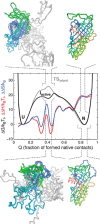Successes and challenges in simulating the folding of large proteins
- PMID: 31712314
- PMCID: PMC6952611
- DOI: 10.1074/jbc.REV119.006794
Successes and challenges in simulating the folding of large proteins
Abstract
Computational simulations of protein folding can be used to interpret experimental folding results, to design new folding experiments, and to test the effects of mutations and small molecules on folding. However, whereas major experimental and computational progress has been made in understanding how small proteins fold, research on larger, multidomain proteins, which comprise the majority of proteins, is less advanced. Specifically, large proteins often fold via long-lived partially folded intermediates, whose structures, potentially toxic oligomerization, and interactions with cellular chaperones remain poorly understood. Molecular dynamics based folding simulations that rely on knowledge of the native structure can provide critical, detailed information on folding free energy landscapes, intermediates, and pathways. Further, increases in computational power and methodological advances have made folding simulations of large proteins practical and valuable. Here, using serpins that inhibit proteases as an example, we review native-centric methods for simulating the folding of large proteins. These synergistic approaches range from Gō and related structure-based models that can predict the effects of the native structure on folding to all-atom-based methods that include side-chain chemistry and can predict how disease-associated mutations may impact folding. The application of these computational approaches to serpins and other large proteins highlights the successes and limitations of current computational methods and underscores how computational results can be used to inform experiments. These powerful simulation approaches in combination with experiments can provide unique insights into how large proteins fold and misfold, expanding our ability to predict and manipulate protein folding.
Keywords: MD simulations; all-atom-based methods; computer modeling; molecular dynamics; multidomain proteins; native-centric simulations; protein folding; protein misfolding; serpin; structure-based model (SBM); tertiary structure.
© 2020 Gershenson et al.
Conflict of interest statement
Pietro Faccioli is a cofounder of Sibylla Biotech, a startup company focused on using advanced molecular simulation methods to develop new therapeutics
Figures







References
Publication types
MeSH terms
Substances
Associated data
- Actions
- Actions
- Actions
- Actions
- Actions
- Actions
- Actions
LinkOut - more resources
Full Text Sources

